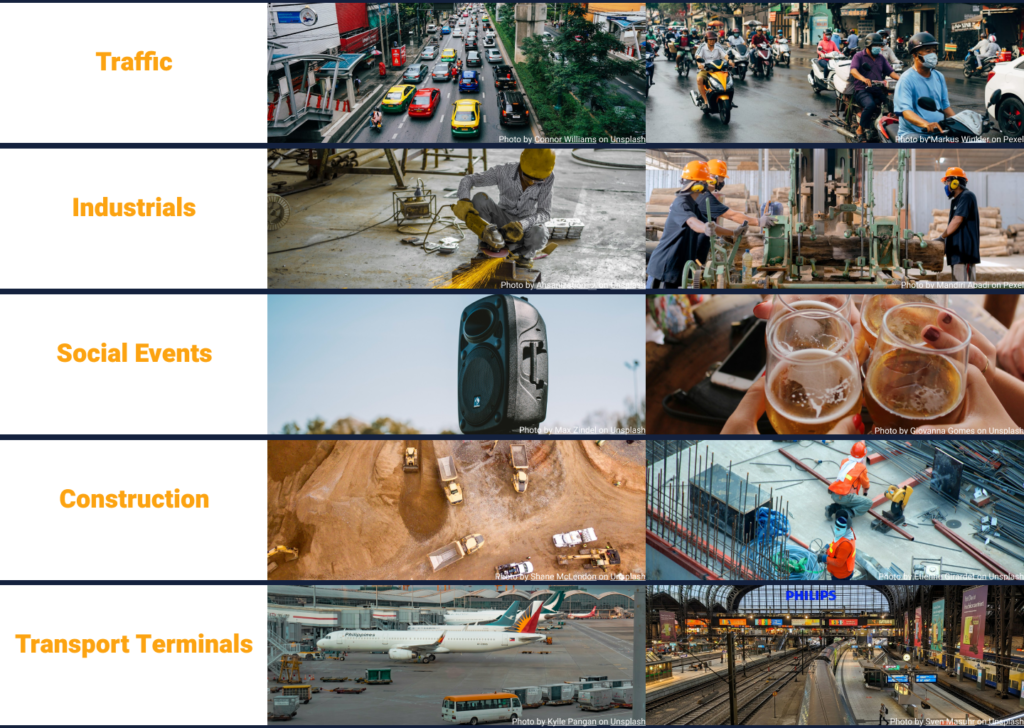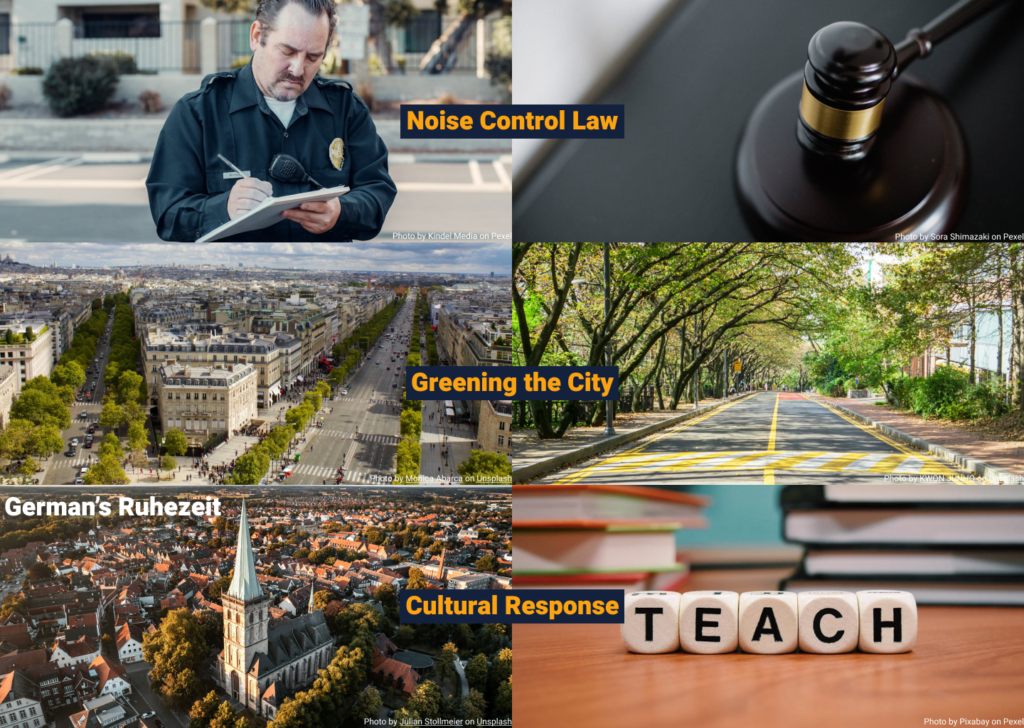Noise pollution is more than just an annoyance; it’s a growing public health issue that’s affecting our physical and mental well-being. In this blog post, we’ll explore what noise pollution is, how it impacts your health, and what we can do to reduce its effects.
What is Noise pollution?
Noise pollution is defined as sound, which is unwanted, either because of its effects on humans, its effect on fatigue or malfunction of physical equipment, or its interference with the perception or deletion of other sounds (Noise Pollution | UNEP Law and Environment Assistance Platform, n.d.P). The World Health Organization (WHO) considers noise above 65 decibels (dB) to be noise pollution. Specifically, noise becomes harmful when it exceeds 75 dB and is painful above 120 dB. As a result, it is recommended that noise levels be kept below 65 dB during the day. Additionally, the WHO indicates that restful sleep is impossible with nighttime ambient noise levels greater than 30 dB (Noise Pollution: How to Reduce the Impact of an Invisible Threat?, 2024).

The common sources of noise pollution are coming from traffic, industries, and social events, constructions, and transport terminals. Those sources are concentrated in urban areas as the world is experiencing rapid urbanisation, so does the rapid noise pollution. Present day, 54 per cent of the world’s population lives in urban areas and it is expected to rise to 66 per cent by the year 2050. Moreover, there are half of all people in ASEAN live in urban areas and an additional 70 million people are forecast to live in ASEAN cities by 2025 (ASEAN Sustainable Urbanisation Strategy, 2018).
The Impact of Noise on Health
According to WHO more than one billion young people (aged 12-35) are at risk of hearing loss due to recreational exposure to loud sounds (New WHO-ITU Standard Aims to Prevent Hearing Loss Among 1.1 Billion Young People, 2019). The noise that comes from transportation is associated with numerous physical health outcomes including ischaemic heart disease (van kempen et al., 2018). Excessive noise can cause annoyance, hearing impairment, tinnitus, and cognitive impairment, with increasing evidence of other health impacts such as adverse birth outcomes and mental health problems. (Compendium of WHO and other UN guidance of health and environment, 2022).
The impact of Noise on Quality of Life
Noise pollution doesn’t just affect your health—it also diminishes your overall quality of life. One of the most noticeable effects is on sleep, which is crucial for both physical and mental restoration. Exposure to nighttime traffic noise can results in insomnia (Śliwińska-Kowalska & Zaborowski, 2017). It is recommended noise levels should be kept below 65 dB during the day and indicates that restful sleep is impossible with nighttime ambient noise levels in excess of 30 dB.
The stress-diathesis hypothesis suggests that transportation noise, as an environmental stressor, can increase physiological arousal and stress hormone secretion (e.g., adrenaline and cortisol) through repeated stimulation of the endocrine system and autonomic nervous system (Babisch, 2002; Hahad et al., 2019; Stansfeld and Clark, 2011, 2015).
What can be done?
What do we do about noise pollution in our cities? There are numerous ways to deal with noise pollution.

Traffic Regulation. Reduce noisy vehicles such as introducing electric and hybrid vehicles, and/or restrict large engine and loud exhaust vehicles from entering urban area. Reduce traffic speed, encourage active mode of transportation such as walking and cycling, and encourage the use of public transports. In Japan, the government invests in low-noise infrastructure such as soundproof train tracks. Subsequently, reducing the traffic volume altogether will reduce the noise generated from traffic.
Soundproofing Infrastructure. Improve residential buildings insulation and install traffic wall to contain noise from heavy traffic roads or highways.
Improve Land Planning. Transport terminals, noisy industrials, airports, and railway terminals should be far away from living spaces and vice versa. Residential developments should not locate near those noisy infrastructure. Moreover, greenbelt should be set as the buffer zone at boundaries between transport terminals, industrial, airport, and railway terminals.

Draft and Implement Noise Control Law. The US’s Noise Pollution and Abatement Act of 1972 aimed to protecting human health and minimising annoyance of noise to the general public. In Singapore, they have Control of Noise at Construction Sites Regulation stated that construction work at the worksite must not exceed the noise limit of 90 dBA over any 5-minute period between 7am to 7pm and must not exceed 75 dBA at the end of specific period from 7am to 7pm. In Japan through Environmental Noise Regulation Act in 1999, sets different noise levels for different times of the day, with maximum allowable noise level during the day set at 55 dB and reduced to 45 dB at night to prevent disturbance to those who are sleeping. Those who break the noise standard will face penalties.
Greening the City. (Margaritis & Kang, 2017) has shown that cities with lower noise levels can possibly achieved by the quantity of green space coverage such as agricultural areas, forest areas, and urban green areas. Cities should increase the density of urban street trees from one row to multiple rows or incorporate traffic calming measures by splitting traffic lane in the middle to create middle zone for planting trees. Additionally, shrubs also absorb noise at the lowest level of the road, and they can be planted alongside street trees.
Cultural Response. Introducing the German concept of “Ruhezeit” – the designation of quiet hours when noise levels are strictly controlled, especially on Sunday. This reflects a proactive approach to mitigating the health impacts of noise pollution and emphasizes the importance of societal efforts in noise management and collective well-being. Noise awareness campaigns can educate the public on the sources and impacts of noise pollution and encourage quieter behaviours. This is particularly relevant in Asian cultures, where weekend celebrations with outdoor karaoke can contribute to noise pollution and peace disturbance.
References
Noise pollution: how to reduce the impact of an invisible threat? (2024). Iberdrola. http://www.iberdrola.com/sustainability/what-is-noise-pollution-causes-effects-solutions
Śliwińska-Kowalska, M., & Zaborowski, K. (2017). WHO Environmental Noise Guidelines for the European Region: A Systematic Review on Environmental Noise and Permanent Hearing Loss and Tinnitus. International Journal of Environmental Research and Public Health, 14(10), 1139. https://doi.org/10.3390/ijerph14101139
Margaritis, E., & Kang, J. (2017). Relationship between green space-related morphology and noise pollution. Ecological Indicators, 72, 921–933. https://doi.org/10.1016/j.ecolind.2016.09.032
Lan, Y., Roberts, H., Kwan, M., & Helbich, M. (2020). Transportation noise exposure and anxiety: A systematic review and meta-analysis. Environmental Research, 191, 110118. https://doi.org/10.1016/j.envres.2020.110118
Mouratidis, K. (2021). Urban planning and quality of life: A review of pathways linking the built environment to subjective well-being. Cities, 115, 103229. https://doi.org/10.1016/j.cities.2021.103229
ASEAN Sustainable Urbanisation Strategy. (2018).
New WHO-ITU Standard Aims to Prevent Hearing Loss Among 1.1 Billion Young People, (2019)